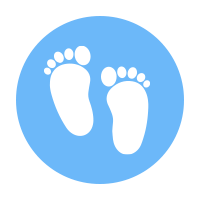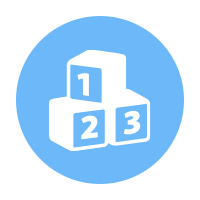At 6 Months:
- Rolls from tummy to back
- Pushes up with straight arms when on tummy
- Leans on hands to support himself when sitting
At 9 Months:
- Gets to a sitting position by herself
- Moves things from one hand to her other hand
- Uses fingers to “rake” food towards himself
- Sits without support
At 12 Months:
- Pulls up to stand
- Walks, holding on to furniture
- Drinks from a cup without a lid, as you hold it
- Picks things up between thumb and pointer finger, like small bits of food
At 6 Months:
- Use “back and forth” play with your baby. When your baby smiles, you smile; when he makes sounds, you copy them. This helps him learn to be social.
- “Read” to your baby every day by looking at colorful pictures in magazines or books and talk about them. Respond to her when she babbles and “reads” too. For example, if she makes sounds, say “Yes, that’s the doggy!”
- Point out new things to your baby and name them. For example, when on a walk, point out cars, trees, and animals.
- Sing to your baby and play music. This will help his brain develop.
- Limit screen time (TV, tablets, phones, etc.) to video calling with loved ones. Screen time is not recommended for children younger than 2 years of age. Babies learn by talking, playing, and interacting with others.
- When your baby looks at something, point to it and talk about it.
- Put your baby on her tummy or back and put toys just out of reach. Encourage her to roll over to reach the toys.
- Learn to read your baby’s moods. If he’s happy, keep doing what you are doing. If he’s upset, take a break and comfort your baby.
- Talk with your baby’s doctor about when to start solid foods and what foods are choking risks. Breast milk or formula is still the most important source of “food” for your baby.
- Learn when your baby is hungry or full. Pointing to foods, opening his mouth to a spoon, or getting excited when seeing food are signs that he is hungry. Others, like pushing food away, closing his mouth, or turning his head away from food tells you that he’s had enough.
- Help your baby learn she can calm down. Talk softly, hold, rock, or sing to her, or let her suck on her fingers or a pacifier. You may offer a favorite toy or stuffed animal while you hold or rock her.
- Hold your baby up while she sits. Let her look around and give her toys to look at while she learns to balance herself.
At 9 Months:
- Repeat your baby’s sounds and say simple words using those sounds. For example, if your baby says “bababa,” repeat “bababa,” then say “book.”
- Place toys on the ground or on a play mat a little out of reach and encourage your baby to crawl, scoot, or roll to get them. Celebrate when she reaches them.
- Teach your baby to wave “bye-bye” or shake his head “no.” For example, wave and say “bye-bye” when you are leaving. You can also teach simple baby sign language to help your baby tell you what he wants before he can use words.
- Play games, such as peek-a-boo. You can cover your head with a cloth and see if your baby pulls it off.
- Play with your baby by dumping blocks from a container and putting them back in together.
- Play games with your baby, such as my turn, your turn. Try this by passing a toy back and forth.
- “Read” to your baby. Reading can be talking about pictures. For example, while looking at books or magazines, name the pictures as you point to them.
- Limit screen time (TV, tablets, phones, etc.) to video calling with loved ones. Screen time is not recommended for children younger than 2 years of age. Babies learn by talking, playing, and interacting with others.
- Find out about choking risks and safe foods to feed your baby. Let him practice feeding himself with his fingers and using a cup with a small amount of water. Sit next to your baby and enjoy mealtime together. Expect spills. Learning is messy and fun!
- Ask for behaviors that you want. For example, instead of saying “don’t stand,” say “time to sit.”
- Help your baby get used to foods with different tastes and textures. Foods can be smooth, mashed, or finely chopped. Your baby might not like every food on the first try. Give her a chance to try foods again and again.
- Say a quick and cheerful goodbye instead of sneaking away so your baby knows you are leaving, even if he cries. He will learn to calm himself and what to expect. Let him know when you return by saying “Daddy’s back!”
At 12 Months:
- Teach your baby “wanted behaviors.” Show her what to do and use positive words or give her hugs and kisses when she does it. For example, if she pulls your pet’s tail, teach her how to pet gently and give her a hug when she does it.
- Talk or sing to your baby about what you’re doing. For example, “Mommy is washing your hands” or sing, “This is the way we wash our hands.”
- Build on what your baby tries to say. If he says “ta,” say “Yes, a truck,” or if he says “truck,” say “Yes, that’s a big, blue truck.”
- Redirect your baby quickly and consistently by giving her a toy or moving her if she is getting into things you don’t want her to get into. Save “no” for behaviors that are dangerous. When you say “no,” say it firmly. Do not spank, yell, or give her long explanations.
- Give your baby safe places to explore. Baby-proof your home. For example, move sharp or breakable things out of reach. Lock away medicines, chemicals, and cleaning products. Save the Poison Help Line number, 800-222-1222, in all phones.
- Respond with words when your baby points. Babies point to ask for things. For example, say “You want the cup? Here is the cup. It’s your cup.” If he tries to say “cup,” celebrate his attempt.
- Point to interesting things you see, such as a truck, bus, or animals. This will help your baby pay attention to what others are “showing” him through pointing.
- Limit screen time (TV, tablets, phones, etc.) to video calling with loved ones. Screen time is not recommended for children younger than 2 years of age. Babies learn by talking, playing, and interacting with others.
- Give your baby water, breast milk, or plain milk. You don’t need to give your baby juice, but if you do, give 4 ounces or less a day of 100% fruit juice. Do not give your baby other sugary beverages, such as fruit drinks, soda, sports drinks, or flavored milks.
- Help your baby get used to foods with different tastes and textures. Foods can be smooth, mashed, or finely chopped. Your baby might not like every food on the first try. Give your baby a chance to try foods again and again.
- Give your baby time to get to know a new caregiver. Bring a favorite toy, stuffed animal, or blanket to help comfort your baby.
- Give your baby pots and pans or a small musical instrument like a drum or cymbals. Encourage your baby to make noise.
- Is there anything your infant does or does not do that concerns you?
- Has your infant lost any skills he/she once had?
- Does your infant have any special healthcare needs or was he/she born prematurely?
If your infant is not meeting one or more milestones, has lost skills he or she once had, or you have other concerns, act early. Talk with your infant’s doctor, share your concerns, and ask about a developmental screening.
If you or the doctor are still concerned:
- Ask for a referral to a specialist who can evaluate your infant more.
- If the evaluation still shows concerns call your state Early Intervention program to find out if your infant can get services to help. Learn more and find the number at Missouri First Steps Program.
What's Next?
Download the Milestone Tracker app today!
Track your child’s milestones from age 2 months to 5 years with the CDC’s easy-to-use illustrated checklists; get tips from the CDC for encouraging your child’s development; and find out what to do if you are ever concerned about how your child is developing. Photos and videos in this app illustrate each milestone and make tracking them for your child easy and fun.













